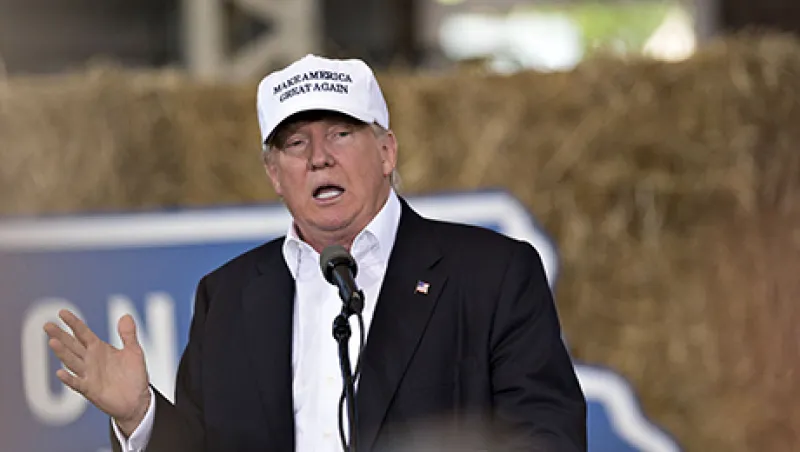With just two months left before the U.S. presidential election, candidates Hillary Clinton and Donald Trump have been giving each other plenty of ammunition. Democratic contender Clinton escaped prosecution for using her personal e-mail account to send sensitive information while serving as secretary of State, but the scandal continues to dog her. Meanwhile, the Bill, Hillary & Chelsea Clinton Foundation has drawn fire from Republicans for allegedly accepting money from foreign donors in exchange for political influence.
GOP nominee Trump is no slouch at sowing controversy and confusion. The billionaire has sabotaged himself by insulting everyone from women and Mexicans to the mother of a slain war hero while also back-pedaling on his pledge to deport millions of illegal immigrants.
Amid these distractions, both candidates have said little about the nation’s retirement security gap. Their relative silence gives short shrift to a serious and growing problem. What do Clinton and Trump really think about retirement, and what action might they take after assuming office in January? The 401(k) plans they offer to the people who work for them and on their behalf yield a few clues.
Voters have good reason to make retirement an election issue for the two nominees. This year more U.S. corporations face class-action suits for allegedly offering defective 401(k) plans, joining the roughly 1,000 companies that have settled since energy trader Enron Corp. collapsed in 2001, taking its employees’ retirement assets down with the ship because of their heavy investment in company stock. In the past two weeks, more than a dozen major universities have also been slapped with such suits.
Meanwhile, more than 30 million full-time private sector workers lack access to a workplace retirement plan, according to the Department of Labor. Of the 58 percent of workers who do have such a plan available to them, only 49 percent participate.
To be fair, Clinton did mention Social Security at last month’s Democratic National Convention in Philadelphia. “If you believe we should expand Social Security ... join us,” she told the crowd while accepting her party’s presidential nomination. Later on the campaign trail, Clinton talked about boosting Social Security benefits for low-income widows and providing credits to unpaid caregivers by raising taxes on the wealthy.
Given that a reduction in Social Security benefits is long-standing Republican Party policy, Trump hasn’t proposed an expansion, but he has declared that he will maintain the financial safety net. “They want to cut your Social Security. I’m not cutting your Social Security,” he said in an April 2 speech in Racine, Wisconsin. “We’re going to save your Social Security as is.”
Social Security is an essential benefit: Nearly two thirds of retired Americans who have paid into the system their entire working lives depend on its modest monthly payments for at least 90 percent of their income. Still, retirement industry experts have long pushed for a better way to save for the future than the patchwork of often expensive plans that leave so many uncovered.
Political sound bites aside, where do Clinton and Trump stand? For some answers, let’s take a look at company 401(k) plans provided by each candidate. Details on these offerings and some 53,000 other defined contribution schemes as of December 31, 2014, appear on the web site of BrightScope, a San Diego–based financial information company that tracks U.S. retirement plans, investment advisers and mutual funds.
The Trump Payroll Corp. 401(k) Profit Sharing Plan manages $27 million in assets. Its 1,500 participants work at 35 of the real estate magnate’s properties, from the Trump National Golf Club in Bedminster, New Jersey, to Wollman Rink, the popular skating venue in New York’s Central Park.
BrightScope gives Trump Payroll Corp. an overall score of 60 out of 100; the highest-rated plan in its payroll services peer group, which BrightScope won’t reveal, gets an 88. The plan’s employee participation gets a below-average rating, as does its average account balance of $26,000. Brooks Herman, BrightScope’s head of data and research, points out that the lackluster participation rate may stem from the hotel and casino business’s notoriously high turnover.
The majority of the plan’s 39 investment options — the peer group’s average is 20, and the best-in-class standard is between 20 and 25 core fund choices — subsidize most of the expenses of recordkeeper Fidelity Investments through a practice known as revenue sharing. “Thus, most of the investments in the plan are not the cheapest share classes of those funds offered,” notes Michael Webb, retirement plan consultant with Cammack Retirement Group, an investment advisory and consulting firm based in New York. Trump Payroll is typical of plans of its size, adds Webb, not the best but far from the worst.
It’s a coincidence that the Trump 401(k) is the same size as the William J. Clinton Foundation Retirement Plan, according to Form 5500s filed with the Department of Labor. The latter plan, sponsored by the Clinton Foundation, where Hillary Clinton has played a minor role at most since declaring her candidacy, also uses the same recordkeeper. But that’s where the similarities end.
The Little Rock, Arkansas–based Clinton plan, whose 750 participants have an average balance of $35,000, achieves a score of 77. Although this plan beats Trump Payroll by 17 points, it barely rises above its own peer group of associations and private foundations. That’s because such organizations typically employ more-affluent workers, who tend to participate in greater numbers and contribute more money than those in the hotel and casino business.
BrightScope lauds the Clinton plan for its relatively low fees. Cammack’s Webb points out that the recordkeeping fee appears to be more favorable than Trump’s –— paying only $37,000 directly to Fidelity compared to Trump Payroll’s $50,000 recordkeeping fee. Thanks to the absence of a revenue-sharing deal with Fidelity, participants can choose from a variety of less expensive institutional class funds that include Vanguard target-date funds. Another strength of the Clinton plan: It has just nine core investment options, plus Vanguard Group’s suite of 11 target-date funds.
“Such a streamlined array is considered to be state-of-the-art in current investment design, as plans have discovered that participants desire investment simplicity,” Webb says. Several studies, including a 2015 report from the Cambridge, Massachusetts–based National Bureau of Economic Research, have also shown that offering too many investment options can lower plan participation rates.
In the end, the difference between the Trump and Clinton retirement savings plans mostly hinges on the sophistication and affluence of the workers who use them. For the U.S. private sector workforce at large, it remains to be seen how much support the next president will give to improving retirement security.






